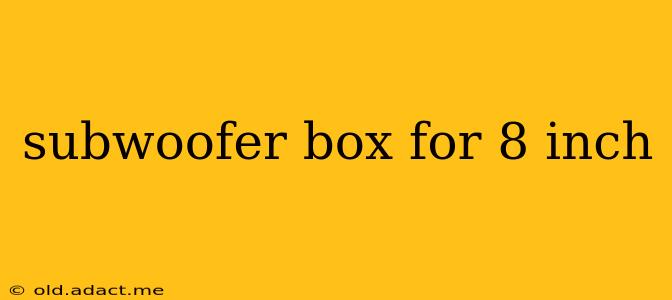Choosing the right subwoofer box is crucial for maximizing the performance of your 8-inch subwoofer. A poorly designed enclosure can severely limit your bass response, resulting in muddy sound or a lack of low-end punch. This comprehensive guide will walk you through the key considerations for building a subwoofer box for your 8-inch driver, ensuring you get the best possible sound from your system.
What Type of Enclosure Should I Use for My 8-Inch Subwoofer?
This is often the first and most important question. There are several enclosure types, each with its own advantages and disadvantages:
-
Sealed (Acoustic Suspension): Sealed enclosures are simple to build, requiring only a well-sealed box. They offer tight, accurate bass with good transient response (how quickly the bass starts and stops). However, they generally produce less overall output than ported or bandpass designs at the same size. This is a great option for smaller spaces or if you prioritize accuracy over sheer volume.
-
Ported (Bass Reflex): Ported enclosures use a port (tube) to extend the low-frequency response of the subwoofer. This results in significantly more output than a sealed enclosure of the same size, particularly in the lower bass frequencies. However, ported boxes can be more complex to design and build, requiring precise calculations to avoid unwanted resonances and distortion. They're ideal for those who want powerful, deep bass.
-
Bandpass: Bandpass enclosures are more complex still and involve two chambers and two ports. They offer extremely high output within a specific frequency range but can be challenging to design and require very precise construction. They are less common for home audio systems.
The best choice for you depends on your priorities (output vs. accuracy), the size constraints of your installation, and your listening preferences. Generally, sealed enclosures are easier for beginners while ported enclosures offer more bass output.
What are the Dimensions for an 8-Inch Subwoofer Box?
There's no single "correct" dimension. The ideal dimensions depend heavily on the enclosure type (sealed, ported, bandpass) and the specific specifications of your 8-inch subwoofer. The subwoofer's manufacturer may provide recommended enclosure parameters (volume, tuning frequency for ported boxes), but even then, slight variations can be acceptable.
Using subwoofer box design software (many free options are available online) is highly recommended. These programs allow you to input your subwoofer's specifications (T/S parameters – Thiele/Small parameters which are usually found in the subwoofer's specifications) and desired enclosure type, and then calculate the optimal internal dimensions. This ensures accurate performance and prevents issues like resonance or excessive distortion.
How Much Internal Volume Does My 8-Inch Subwoofer Need?
The required internal volume (box size) varies significantly based on the enclosure type and the subwoofer's parameters. A sealed enclosure generally requires less volume than a ported one for the same subwoofer.
Again, subwoofer design software is essential here. Inputting the subwoofer's T/S parameters will provide the optimal volume. Using an incorrect volume can drastically affect the bass response, leading to a disappointing listening experience.
What Materials Should I Use to Build My Subwoofer Box?
Common materials include:
-
Medium-Density Fiberboard (MDF): MDF is a popular choice due to its density, stiffness, and relatively low cost. It dampens vibrations well, leading to a cleaner sound.
-
Particle Board: Less expensive than MDF, but less dense and may require additional damping material.
-
Plywood: While strong, plywood can be more difficult to work with and may require more bracing to prevent vibrations.
Ensure your chosen material is appropriately thick (at least ¾ inch or 19mm is generally recommended for good rigidity) to minimize unwanted resonances.
How Do I Seal My Subwoofer Box Properly?
Proper sealing is paramount. Leaks will significantly impact bass response, causing unwanted resonances and reducing output. Use wood glue and appropriate sealant (like silicone caulk) to ensure a completely airtight seal between all joints. Pay close attention to the corners and any areas where the panels meet.
By carefully considering these factors and utilizing subwoofer design software, you can build a high-performance subwoofer box that will let your 8-inch subwoofer shine. Remember to always prioritize accurate calculations and precise construction for optimal results.
